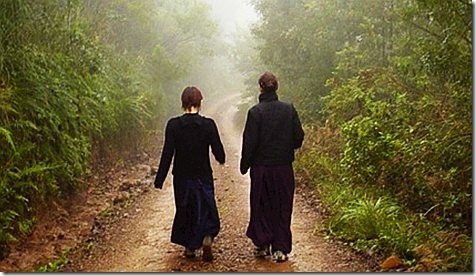This is the first part of a two-part article.

photo by Maren Yumi on flickr CC BY-NC-SA 2.0
It’s been a few years since I last wrote about conversation. I don’t see nearly the value in conversation that I used to. I still talk too much, and seemingly converse a lot, still mostly about subjects that are unactionable and don’t really matter. Old habit I suppose; this is long-conditioned behaviour. Language ties up the brain in comprehension and conception when the brain could be used, silently, for perception, for sensing and intuition and letting things come, and for demonstration and attention, which, even before embracing radical non-duality, I’d come to believe are much better uses of our bewildered brains.
I have come to distinguish real conversation (which etymologically means “turning with”, almost like dance, and which is a collaborative, interactive, iterative activity), from non-collaborative, one-way forms of talking including performance (relating something), instruction, and inquiry (Q&A), whose purpose is to tell a story, entertain, or give or get clarity, and which has a clear “audience”. These might be serial, with one person at a time spouting forth, but they are not really conversations. And if the back-and-forth results from a need for clarity due to inarticulate or lazy exposition, or a craving for reassurance, that’s not really conversation either.
So why should we ever need to converse? If not to relate information, tell a story, get clarity (ie learn), reassure, show affection, or entertain, what purpose does real, collaborative, interactive, iterative conversation serve?
I think real conversation can serve four purposes: to surface insights, to see different perspectives, to achieve consensus on decisions, and to resolve conflicts. These purposes are related: Seeing different perspectives and surfacing insights can help resolve conflicts and achieve consensus. They are about using a deliberative process to move beyond the fixed thoughts and ideas in our own heads and to appreciate others’ ways of thinking and seeing, with the goal of achieving agreement and cohesion with others we live and work with.
Here are the most important prerequisites, in my experience, for an effective conversation to achieve one or more of the above purposes:
- Capacity to be open to other and difficult ideas and perspectives: There is no point trying to collaborate with someone who is either incapable of considering or unwilling to consider different possibilities. If someone is totally set in their beliefs, or utterly lacking in imagination, conversation is futile.
- A basic level of capacity to articulate, and of social fluency: Articulation is the ability to convey one’s thoughts, ideas, beliefs and perspectives clearly. Social fluency is the emotional engagement and sensitivity to appreciate (and show appreciation for) others’ thoughts, ideas, beliefs and perspectives and see how and why they might be different from one’s own.
- Critical thinking skills: The capacity to draw inferences, challenge assumptions, weigh evidence, and synthesize information is essential to the development of a rational and thoughtful worldview and belief system. If you, or those you are conversing with, lack these skills, you can’t possibly hope to reason with them.
- Curiosity and creative/imaginative skills: Some people, for various reasons, are just shut down and unwilling to consider anything that doesn’t jibe with their ideology or belief set; others, through lack of practice, have lost the capacity to imagine anything that isn’t simple and obvious, or to put themselves in another’s shoes. Conversations with such people are likely to be just frustrating and pointless.
- Attention skills: We live in a world of attention deficit, distraction and information overload. In such a world, listening and paying attention are challenging and take practice. If those you’re conversing with don’t have and use these skills, they won’t hear you, so you’re wasting your breath.
You’ve probably noticed that these five prerequisites to effective conversation are all capacities; the people in the supposed conversation either have them or they don’t.
What I’ve discovered of late is that in most of the discussions I have (a) people don’t have one or more of the four purposes (to surface insights, to see different perspectives, to achieve consensus on decisions, and to resolve conflicts) for which conversations are well-suited; and (b) few of the participants have the five prerequisite skills for effective conversation.
Small wonder, then, that I find most attempts at real conversation fail. In the rare cases that true conversation occurs (often with the help of a skilled facilitator, who might also be one of the participants) the result can be magic.
Alas, as the world becomes more stressful, less attentive, more polarized and less socially fluent, such conversations seem to be increasingly rare.
Perhaps that is why some of us have been shying away from social discourse and spending more of our time in silence. I’ll explore that more in Part Two of this article.
Thanks to John Kellden and Michael Dowd for inspiring this post





E.O. Wilson, in The Origin of Creativity, claims that:
‘We sense fewer than one thousandth of one percent of the diversity of molecules and energy waves that constantly sweep around and through us.’ and:
‘Our minds are accordingly limited. Our hope for full self-understanding depends on knowledge not just of ourselves but of the specialization of the other living systems around us.’
A naturalist tends to work alone, paying meticulous attention to what he or she sees, hears, feels, etc. But Wilson is talking about the much broader scope of all the things that science reveals are there, but which we cannot sense directly. I suggest that, if we hope to achieve Wilson’s goal, we need to somehow partner with other humans who understand these unseen phenomena better than we do ourselves…or, better yet, collaborate with people who understand some part of the total phenomena so that the two of us, or the sum of us, achieve the understanding that Wilson identifies.
Exactly how that can be facilitated remains to be seen.
Don Stewart